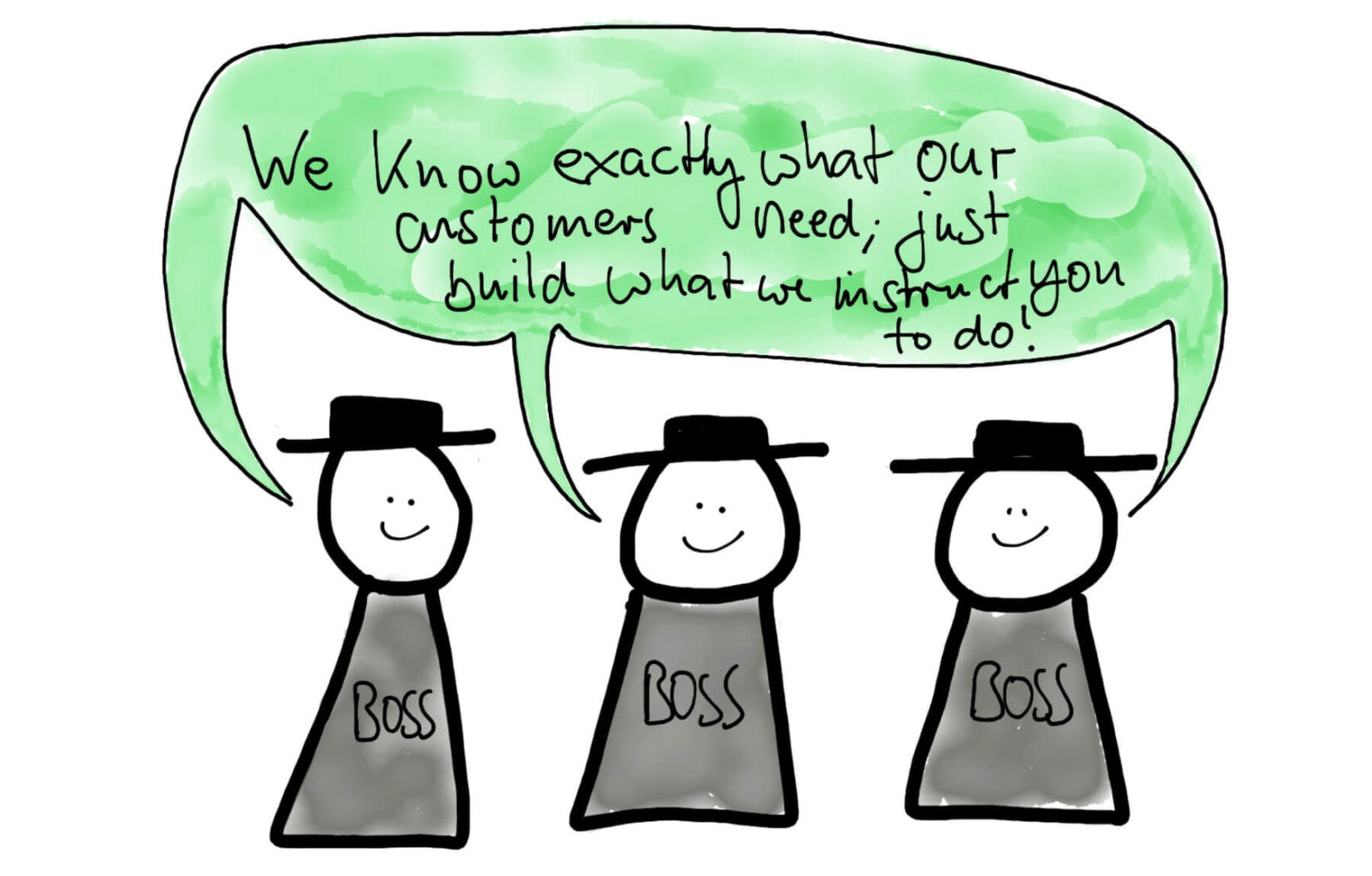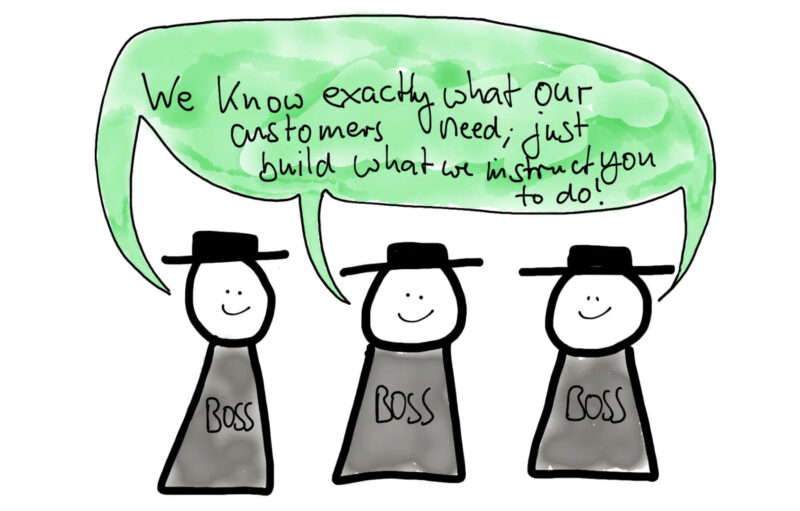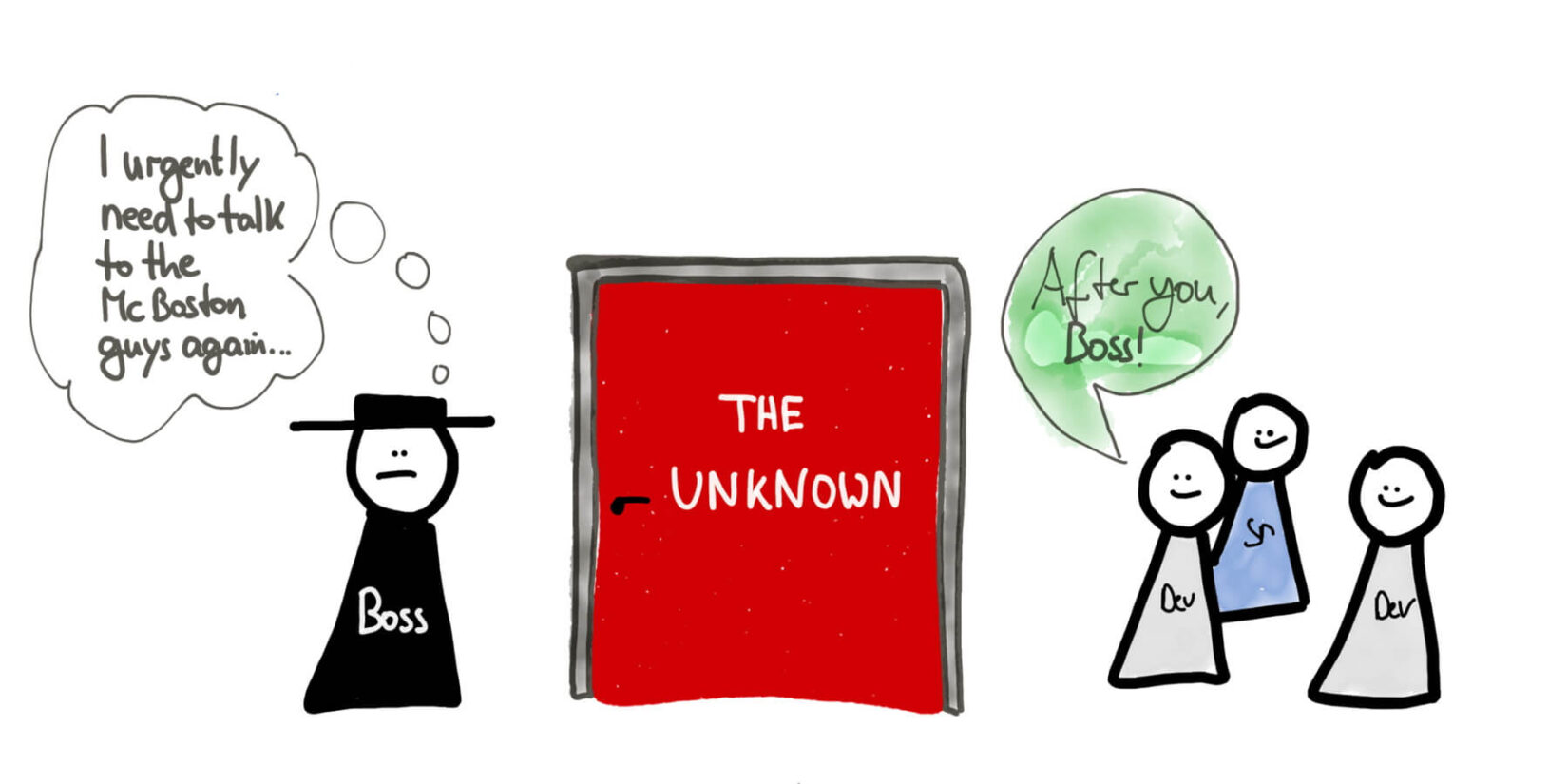TL; DR: System-Level Scrum Stakeholder Anti-Patterns
Learn how outdated organizational structures manifest themselves in system-level Scrum stakeholder anti-patterns that easily impede any agile transformation to a product-led organization. We cover the perils of a lack of transparency, limited to non-existing leadership support, and why penny-pinching is the wrong approach.

🇩🇪 Zur deutschsprachigen Version des Artikels: Die drei wichtigsten Scrum Stakeholder Anti-Muster auf Systemebene.
🎓 July 1, 2024: Learn to Master Your Most Important Artifact w/ the Advanced Product Backlog Management Course for Just $99!
👉 Please note:
- The course includes membership in a new community of agile professionals.
- Become fully reimbursed if you choose to join the Advanced Product Backlog Management Cohort of June 13-July 11, 2024, at € 399.
- The course will only be available until July 8, 2024, for sign-up!
The most popular discussion on LinkedIn last week was: Is SAFe a useful agile framework despite its reputation? Despised, yet practiced?!
🗞 Shall I notify you about articles like this one? Awesome! You can sign up here for the ‘Food for Agile Thought’ newsletter and join 42,000-plus subscribers.
🎓 Join Stefan in one of his upcoming Professional Scrum training classes!
Common Scrum Stakeholder Anti-Patterns
Let us start with considering some reasons for the existence of common Scrum stakeholder anti-patterns. Five main categories come to mind:
- Fear of Change: Stakeholders in the organization may fear losing power, control, or comfort with the familiar. The Agile Manifesto values “individuals and interactions over processes and tools,” but this shift could mean abandoning existing hierarchies, which may make stakeholders anxious.
- Siloed Structures: Functional silos are critical elements of the legacy organizational design, reflected in many stakeholders’ status and remuneration. Preserving them for political reasons hinders cross-functional collaboration, an essential aspect of agile.
- Misaligned Incentives: The organization may have still tied some management incentives to traditional performance measures incompatible with Scrum or agile principles. (Quote: Charlie Munger: “Never, ever, think about something else when you should be thinking about the power of incentives.”)
- Short-term Focus: Legacy organizations often focus on immediate results, which clashes with Scrum’s focus on long-term sustainability.
- Resistance to Learning: Becoming agile requires unlearning old practices and learning new ones. This learning curve can be intimidating. Additionally, stakeholders may receive insufficient training and coaching.
As a result, the organization may limit ‘becoming agile’ to product and engineering teams while the rest of the organization continues practicing the industrial age principles. The following examples of system-level Scrum stakeholder anti-patterns often tend to become most damaging in that respect:
1. Lack of Transparency
Observation: The organization is not transparent about vision and strategy; hence, the Scrum Teams are hindered from becoming self-managing.
Background: “If you don’t know where you are going, any road will get you there.” In a complex environment with high levels of competition and uncertainty, everyone needs to understand the Why, the What, the How, and the Who. A lack of transparency will stop any effort to become agile dead in the tracks as those interested in change likely won’t flock to the cause. Elon Musk’s “The Secret Tesla Motors Master Plan (just between you and me)” is an excellent example of leadership transparency at the vision and strategic level.
There are some reasons for this secrecy:
- Legacy Hierarchical Structure: In traditional hierarchical structures, information flow is often top-down. The notion of transparency across all levels can be unfamiliar and uncomfortable.
- Fear of Losing Control: Leadership may feel that by revealing their vision and strategy, they will lose control over the company’s direction.
- Fear of Information Misuse: Leadership might fear that transparency about vision and strategy could lead to misuse of information by competitors or even employees, perpetuating the information principle of sharing on a “need-to-know basis.”
- Perceived Inefficiency: Leaders may believe that sharing strategic information with everyone could lead to debates, slowing down decision-making processes.
- Uncertainty or Lack of Clarity: Sometimes, the leadership may not have a clear vision or strategy. Hence, they cannot communicate what they don’t fully understand, leading to a lack of transparency.
Remedy: While the Scrum Guide does not provide any information on accomplishing the transformation of legacy organizations to agile organizations, there are some perspectives on what you can attempt to overcome the lack of transparency at the leadership level:
- Promote Transparency: Actively advocate for a more transparent environment and use the Scrum values, particularly “Openness,” as a basis for this argument. Encourage leadership to understand the importance of sharing the company’s vision and strategy.
- Facilitate Communication: Facilitate regular meetings where executives can share strategic updates beyond Scrum events. Also, encourage Developers and the Product Owner to ask questions directly to the leadership team to clarify the direction and align on the objectives.
- Influence Through Education: Provide training or workshops to the leadership team. Highlight how transparency can empower teams, increase engagement, and ultimately drive better product outcomes.
- Visualize Strategy: Use artifacts like a Product Roadmap to visualize the strategy and connect it to the team’s Product Goal, its Product Backlog, and its Sprint Backlog, making the alignment of the daily work with the big picture more tangible.
- Celebrate Success: Publicly recognize when transparent behavior leads to positive outcomes, encouraging more people in the organization to see and adopt the benefits of transparency.
2. Lack of Leadership Support
Observation: Senior management is not participating in agile processes, for example, the Sprint Reviews, despite being a role model. Instead, they stay in their comfort zone and expect a different form of (push) reporting.
Background: The support of the upper management is mission-critical for any transformation. No Scrum Team will be successful if the ‘leadership’ is not leading the effort; for example, attending Sprint Reviews to signal to everyone in the organization: Becoming agile is here to stay; it is not a fad.
Remedy: There are ways we can convince the leadership team to “lead” the change effort:
- Create a Shared Vision: Help leaders create a shared vision for the Agile transformation and articulate why it matters for the company. This way, they have a story to tell their teams, helping to drive engagement and buy-in.
- Ask for Their Support: Don’t be shy about directly asking for their involvement. Explain why their participation is critical and how it can benefit the entire organization.
- Show Agile’s Value: Use data to showcase how adopting agile practices can deliver better results. Use actual case studies, either from within the company or from successful agile transformations in similar companies.
- Peer Influence: Arrange for leadership to meet with executives from other companies who have successfully undergone Agile transformations. These peers can share their experiences and insights, which might be more persuasive.
- Involve Leaders: Invite them to actively participate in events like Sprint Reviews, which will give them firsthand experience of Scrum in action and the benefits it can bring.
- Change the Reporting Style: Use Scrum artifacts like a Product Backlog or Sprint Backlog to demonstrate progress instead of traditional reports, making the agile processes more tangible for them.
- Train and Educate: Provide Agile and Scrum training sessions specifically tailored for leaders, helping them understand the value, principles, and practices of Agile and how they can lead by example.
3. Scrum on a Tight Budget
Observation: The organization does not spend adequate time and budget on proper communication, training, and coaching to create a shared understanding of Scrum’s purpose and direction among all organization members.
Background: Unlike your typical process initiative, it is impossible to decree and roll out Scrum, probably even outsourcing that process to a third party, such as a consulting company. Consequently, becoming agile and embracing business agility is a monumental and expensive undertaking. To reap a competitive advantage, it requires fostering a culture that values collaboration, responsiveness to change, and continuous improvement.
Moreover, while these expenditures become immediately apparent, the organization may not reap the return on investment for years to come, and cutting back on necessary expenses early in the transformation will make failure more likely.
What might be why an organization embarks on becoming agile and embracing business agility but also decides to sabotage itself by not allocating sufficient financial means to accomplish its intention? Some of those reasons may be as follows:
- Misunderstanding of Agile: Organizations might perceive Agile and Scrum as merely process frameworks that don’t require an extensive financial commitment. They underestimate the financial investment needed to overhaul practices, culture, and mindset.
- Short-term Focus: Leadership may prioritize immediate financial results over long-term strategic benefits, confusing “becoming agile” as a path to score a short-term gain.
- Budget Constraints: Economic challenges or existing financial commitments may lead to underinvestment in an agile transformation. The organization may believe it can make do with less.
- Perceived as a Cost Center: Some organizations view expenses related to agile transformation (training, coaching, tooling) as a cost center, not an investment in future productivity and adaptability.
- Resistance to Change: Some leaders may hesitate to allocate significant resources to a transformation they don’t fully understand or believe in.
- Overconfidence: The organization might believe its employees can manage the transition without extensive support, training, or coaching, overlooking the need for expert guidance and the time it takes for people to adapt to new ways of working.
- Undervaluing Communication and Training: Organizations may underestimate the importance of effective communication and education in a successful transformation, dismissing those as “soft skills.”
Remedy: Some approaches to deal with insufficient funding for your transition to Scrum are:
- Pitch the Value of Agile: Help the leadership understand the tangible benefits of agile transformation, such as faster time to market, higher customer satisfaction, increased team productivity, and adaptability to change.
- Get an Ally: Find a sponsor or a champion in the leadership who understands the value of an agile transformation and is willing to advocate for it.
- Present Case Studies: Share successful agile transformation stories from similar companies or industries. Highlight the investments these organizations made and the benefits they reaped over time.
- Facilitate Learning: Host workshops or seminars on Agile and Scrum for the leadership. Invite agile consultants or experienced agile practitioners who can provide insights into the journey, the investment needed, and the potential return on investment.
- Propose a Pilot Program: If the organization hesitates to invest heavily, suggest a “pilot agile transformation” with one Scrum Team, allowing the organization to see firsthand benefits without a massive upfront investment.
- Show Incremental Improvement: Adopt an iterative approach to demonstrating improvements. Start with small, inexpensive changes showing potential, then build on those successes to justify the more significant investment. For example, your pilot’s Sprint Reviews events are well-suited for that purpose.
As per the Scrum Guide, the role of a Scrum Master includes promoting and supporting Scrum by helping everyone understand Scrum theory, practices, rules, and values. This role concept includes that the organization understands the investment needed to reap the full benefits of a transformation to Scrum.
System-Level Scrum Stakeholder Anti-Patterns — Conclusion
There are many different reasons why Scrum stakeholders do not act in line with agile principles. Some result from organizational debt, particularly in legacy organizations from the industrial area. Some are intrinsically motivated, for example, by personal agendas, while others originate from a lack of training or anxieties. Whatever the reason, Scrum stakeholder anti-patterns need to be overcome to turn an agile transformation into a success. Otherwise, you might end up in some form of cargo-cult agile or Scrumbut.
Which system-level Scrum stakeholder anti-patterns have you observed? Please, share them with us in the comments.
📖 System-Level Scrum Stakeholder Anti-Patterns — Related Posts
27 Sprint Anti-Patterns Holding Back Scrum Teams
Scrum: 20 Sprint Planning Anti-Patterns
Daily Scrum Anti-Patterns: 24+2 Ways to Improve as a Scrum Team
15 Sprint Review Anti-Patterns Holding Back Scrum Teams
21 Sprint Retrospective Anti-Patterns Impeding Scrum Teams
Download the Scrum Anti-Patterns Guide for free.
📅 Join Our Scrum Training Classes, Workshops, and Events to Improve your Skills
See all upcoming classes here.
You can book your seat for the training directly by following the corresponding links to the ticket shop. If the procurement process of your organization requires a different purchasing process, please contact Berlin Product People GmbH directly.
✋ Do Not Miss Out — Join the 19,000-plus Strong ‘Hands-on Agile’ Slack Community
I invite you to join the “Hands-on Agile” Slack Community and enjoy the benefits of a fast-growing, vibrant community of agile practitioners from around the world. Learn more about System-Level Scrum Stakeholder Anti-Patterns!
If you like to join all you have to do now is provide your credentials via this Google form, and I will sign you up. By the way, it’s free.
Support your team to overcome system-level Scrum Stakeholder Anti-Patterns by pointing to the free Scrum Anti-Patterns Guide:





